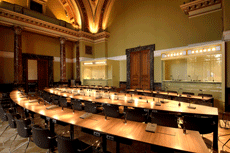Organisation
Member States
The Central Commission has five Member States: Germany, Belgium, France, the Netherlands, and Switzerland. The number of members has varied throughout the Commission’s history. In previous times, the various German States were directly represented. After the First World War, the Federal State took the place of the Länder. Shortly after the First World War, the Treaty of Versailles made provision for the membership of the allied powers - Belgium, Italy and the United Kingdom, plus Switzerland. Italy and the United Kingdom renounced participation in 1935 and 1993 respectively. The United States was a member of the Central Commission after the Second World War as occupation power and resigned its membership in 1961.
The adhesion of new members would require the adoption of an Additional Protocol.

Plenary meeting
Plenary meetings are held twice a year, in the spring (late May) and the autumn (late November). They are attended by representatives of the Member States. Each State may designate four full commissioners and two substitutes. The delegations may also include a delegation secretary and a number of national experts.
The plenary meeting is the CCNR’s decision-making body. It adopts the Central Commission’s resolutions. Each State has one vote, and decisions are reached unanimously. The meeting is chaired by a representative of the Member States alternately, with a two-year term of office (Articles 43 to 44 ter of the Mannheim Document and Articles 5 to 16 of the Rules of Procedure).
In certain cases, the plenary meeting has delegated the power to reach decisions on less important issues to its committees.
Observer States and observer international organisations are invited to attend plenary meetings.
The Central Commission’s resolutions may be found here.

Committees and working parties
The plenary meeting’s resolutions are prepared by committees and working parties (Articles 17 to 25 of the Rules of Procedure). These play a key role in the work of the Central Commission. There are about ten committees:
- the Budget Committee,
- the Administrative Sub-Committee,
- the Preparatory Committee,
- the Economic Committee,
- the River Law Committee,
- the Police Regulations Committee,
- the Inspection Regulations Committee,
- the Dangerous Substances Committee,
- the Committee for Infrastructure and Environment,
- the Committee on Social Issues, Employment and Professional Training,
and about fifteen working parties:
- the working party on the Police Regulations,
- the working party on the Inspection Regulations,
- the working party on RIS,
- the working party for Infrastructure and Environment,
- the steering committee on the International Safety Guide for Inland Navigation Tank-barges and Terminals (ISGINTT) and the ISGINTT group’s working group (ISGINTTwg),
- the group on the safety of river transport in the face of acts of terrorism,
Most of the committees comprise at least one full commissioner or substitute commissioner for each Member State and experts designated by them. Meetings are usually held twice a year, but sometimes more frequently. In some cases the committees’ work is prepared by working parties. The composition of the working parties depends on the missions entrusted to them; they may also include external qualified persons.
The observer States are invited to take an active part in committees and working parties. The approved non-governmental organisations may be heard by the committees or take part in the working parties.
The work of the committees and working parties are prepared by the Secretariat and the delegations. The Secretariat draws up the draft agendas and drafts the minutes, and implements the measures adopted by the committees.
Thanks to the close integration of the contributions of the national delegations, the representatives of the industry, the experts and the Secretariat, most of the projects of the committees and working parties are drawn up on the basis of consensus, which makes effective decision-making possible despite the unanimity rule that applies to the plenary meeting.

Meetings and activity programmes

Meetings are usually held in Strasbourg, but they may be held elsewhere. The CCNR holds about a hundred meetings of all kinds over the year. The activities of the committees and working parties are defined in work programmes that the Central Commission draws up for a two-year period. These programmes define a hierarchy of priorities for the work to be carried out. ![]()
![]()
![]()
Work is carried out in the three working languages of the Central Commission.
The CCNR has drawn up Rules of Procedure that describe the functioning of the Central Commission and its various bodies. The Rules of Procedure have the same value as a resolution.


